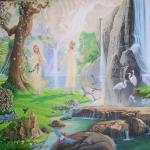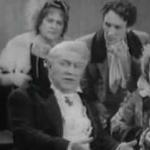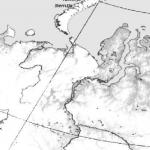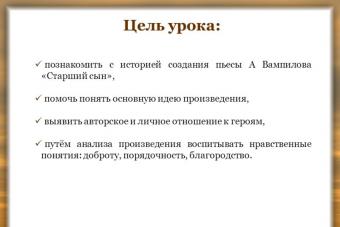slide 1
Leo Nikolaevich Tolstoy.
(1828-1910)
slide 2

Origin
Representative of the Count's branch of the noble family of Tolstoy, descended from Peter's associate P. A. Tolstoy. The writer had extensive family ties in the world of the highest aristocracy.
slide 3

Childhood
"Happy, happy, irretrievable time of childhood! No matter how you love or cherish the memories of her? These memories refresh, elevate my soul and serve as a source of pleasure for me ...
Leo Tolstoy was born on August 28, 1828 in the Krapivensky district of the Tula province, in the hereditary estate of his mother - Yasnaya Polyana. He was the fourth child in the family. His mother, nee Princess Volkonskaya, died when Tolstoy was not yet two years old.
slide 4

But according to the stories of family members, he had a good idea of \u200b\u200b"her spiritual appearance": some of the features of his mother (a brilliant education, sensitivity to art, a penchant for reflection. Tolstoy's father, a participant in the Patriotic War, remembered by the writer for his good-natured and mocking character, love of reading, hunting (died early (1837)).
slide 5

The upbringing of children was carried out by a distant relative T. A. Ergolskaya, who had a huge influence on Tolstoy: "she taught me the spiritual pleasure of love." Childhood memories have always remained the most joyful for Tolstoy: family traditions, the first impressions of the life of a noble estate served as rich material for his works, were reflected in the autobiographical story "Childhood".
slide 6

Kazan University
When Tolstoy was 13 years old, the family moved to Kazan, to the house of P. I. Yushkova, a relative and guardian of the children. In 1844 Tolstoy entered Kazan University in the Department of Oriental Languages of the Faculty of Philosophy. Then he transferred to the Faculty of Law, where he studied for less than two years: the classes did not arouse a lively interest in him, and he indulged in secular entertainment with passion.
Slide 7

In the spring of 1847, having submitted a letter of resignation from the university "due to poor health and domestic circumstances", Tolstoy left for Yasnaya Polyana with the firm intention of studying the entire course of legal sciences (in order to pass the exam as an external student), "practical medicine", languages, agriculture, history, geographical statistics, write a dissertation and "achieve the highest degree of perfection in music and painting."
Slide 8

"The turbulent life of adolescence"
After a summer in the countryside, disappointed by the unsuccessful experience of managing on new, favorable conditions for serfs (this attempt is captured in the story The Morning of the Landowner, 1857), in the fall of 1847 Tolstoy left first for Moscow, then for St. Petersburg to take candidate exams at the university.
Slide 9

His way of life during this period often changed: either he prepared for days and passed exams, then he passionately devoted himself to music, then he intended to start a bureaucratic career, then he dreamed of becoming a cadet in a horse guard regiment. Religious moods, reaching asceticism, alternated with revelry, cards, trips to the gypsies.
Slide 10

In the family, he was considered "the most trifling fellow", and he managed to repay the debts he had made then only many years later. However, it was these years that were colored by intense introspection and struggle with oneself, which is reflected in the diary that Tolstoy kept throughout his life. At the same time, he had a serious desire to write and the first unfinished artistic sketches appeared.
slide 11

"War and Freedom"
The Caucasian nature and the patriarchal simplicity of the Cossack life, which struck Tolstoy in contrast with the life of the noble circle and with the painful reflection of a man of an educated society, provided material for the autobiographical story The Cossacks (1852-63). Caucasian impressions were also reflected in the stories "Raid" (1853), "Cutting the Forest" (1855), as well as in the late story "Hadji Murad" (1896-1904, published in 1912).
In 1851, his elder brother Nikolai, an officer in the army, persuaded Tolstoy to travel together to the Caucasus. For almost three years, Lev Nikolaevich Tolstoy lived in a Cossack village on the banks of the Terek, leaving for Kizlyar, Tiflis, Vladikavkaz and participating in hostilities (at first voluntarily, then he was hired).
slide 12

Returning to Russia, Tolstoy wrote in his diary that he fell in love with this "wild land, in which two most opposite things - war and freedom - are so strangely and poetically combined." In the Caucasus, Tolstoy wrote the story "Childhood" and sent it to the journal "Sovremennik" without revealing his name (published in 1852 under the initials L. N.; together with the later stories "Boyhood", 1852-54, and "Youth", 1855 -57, compiled an autobiographical trilogy). The literary debut immediately brought real recognition to Tolstoy.
slide 13

Crimean campaign
In 1854 Leo Tolstoy was assigned to the Danube army in Bucharest. Boring staff life soon forced him to transfer to the Crimean army, to the besieged Sevastopol, where he commanded a battery on the 4th bastion, showing rare personal courage (he was awarded the Order of St. Anne and medals).
Slide 14

Tolstoy was captivated by new impressions and literary plans (he was also going to publish a magazine for soldiers), here he began to write a cycle of “Sevastopol stories”, which were soon published and had a huge success (Even Alexander II read the essay “Sevastopol in December”.
The first works struck literary critics with the boldness of psychological analysis and the detailed picture of the “dialectic of the soul” (N. G. Chernyshevsky).
slide 15

Some of the ideas that appeared during these years make it possible to guess in the young artillery officer the late Tolstoy the preacher: he dreamed of "founding a new religion" - "the religion of Christ, but purified from faith and mystery, a practical religion."
slide 16

In the circle of writers
After the end of the Crimean War, Tolstoy left the army and returned to Russia. Arriving home, the author enjoyed great popularity on the literary scene of St. Petersburg.
Slide 17

In November 1855, L. Tolstoy arrived in St. Petersburg and immediately entered the Sovremennik circle (Nikolai Alekseevich Nekrasov, Ivan Sergeevich Turgenev, Alexander Nikolayevich Ostrovsky, Ivan Alexandrovich Goncharov and others), where he was greeted as "the great hope of Russian literature" (Nekrasov) .
Slide 18

“These people disgusted me, and I disgusted myself.”
Tolstoy took part in dinners and readings, in the establishment of the Literary Fund, was involved in disputes and conflicts of writers, but he felt like a stranger in this environment, which he described in detail later in Confession (1879-82):
Slide 19

Abroad
In the autumn of 1856, having retired, Tolstoy left for Yasnaya Polyana, and in 1857, declaring himself an anarchist, he left for Paris. Once there, he lost all his money and was forced to return home to Russia.
Slide 20

He visited France, Italy, Switzerland, Germany (Swiss impressions are reflected in the story "Lucerne"), returned to Moscow in the fall, then to Yasnaya Polyana.
slide 21

folk school
Returning to Russia in 1862, Tolstoy published the first of 12 issues of the thematic magazine Yasnaya Polyana. In the same year, he married the daughter of a doctor named Sofya Andreevna Bers.
slide 22

In 1859, Leo Tolstoy opened a school for peasant children in the village, helped set up more than 20 schools in the vicinity of Yasnaya Polyana, and Tolstoy was so fascinated by this occupation that in 1860 he went abroad again to get acquainted with the schools of Europe.
slide 23

Tolstoy outlined his own ideas in special articles, arguing that the basis of education should be the "student's freedom" and the rejection of violence in teaching.
In 1862 he published the pedagogical journal Yasnaya Polyana with books for reading as an appendix, which became in Russia the same classic examples of children's and folk literature as those compiled by him in the early 1870s. Alphabet and New Alphabet.
slide 24

Fracture (1880s)
The course of the revolution that took place in the mind of Leo Tolstoy was reflected in artistic creativity, primarily in the experiences of the characters, in the spiritual insight that refracts their lives.
These heroes occupy a central place in the stories "The Death of Ivan Ilyich" (1884-86), "Kreutzer Sonata" (1887-89, published in Russia in 1891), "Father Sergius" (1890-98, published in 1912), drama " Living Corpse" (1900, unfinished, published 1911), in the story "After the Ball" (1903, published 1911).
Slide 25

The new outlook of the writer is reflected in the "Confession". In general, he "felt that what he stood on had given way, that what he had lived for was gone." The natural result was the thought of suicide: “I, a happy man, hid the string from me so as not to hang myself on the crossbar between the cabinets in my room, where every day I was alone, undressing, and stopped going hunting with a gun, so as not to be too tempted an easy way to get rid of life. I myself did not know what I wanted: I was afraid of life, aspired away from it and, meanwhile, hoped for something else from it, ”wrote Tolstoy.
slide 26

Lev Nikolaevich sought the meaning of life in the study of philosophy, in acquaintance with the results of the exact sciences. He tried to simplify as much as possible, to live a life close to nature and agricultural life.
Slide 27

Gradually, Tolstoy renounces the whims and conveniences of a rich life (simplification), does a lot of physical labor, dresses in the simplest clothes, becomes a vegetarian, gives his family all his large fortune, renounces literary property rights.
Slide 28

On the basis of a sincere desire for moral improvement, the third period of Tolstoy's literary activity is created, the distinguishing feature of which is the denial of all established forms of state, social and religious life.
slide 32

In the late autumn of 1910, at night, secretly from his family, the 82-year-old Tolstoy, accompanied only by his personal doctor D.P. Makovitsky, left Yasnaya Polyana.
Letter to L.N. Tolstoy's wife, left before leaving Yasnaya Polyana. 1910 October 28. Yasnaya Polyana. My departure will upset you. I regret this, but understand and believe that I could not have done otherwise. My position in the house is becoming, has become unbearable. Apart from everything else, I can no longer live in the conditions of luxury in which I lived, and I do what old people of my age usually do: they leave worldly life to live in solitude and quiet for the last days of their lives. Please understand this and don't follow me if you find out where I am. Such your arrival will only worsen your and my situation, but will not change my decision. I thank you for your honest 48-year life with me and ask you to forgive me for everything that I was guilty of before you, just as I forgive you with all my heart for everything that you could be guilty of before me. I advise you to make peace with the new position in which my departure puts you, and not to have an unkind feeling against me. If you want to tell me something, tell Sasha, she will know where I am and will send me what I need; she cannot say where I am, because I made her promise not to tell this to anyone. Lev Tolstoy. 28 of October. I instructed Sasha to collect my things and manuscripts and send them to me. L. T.
The word is a great thing. Great because with a word you can unite people, with a word you can also separate them, with a word you can serve love, with a word you can serve enmity and hatred. Beware of such a word that divides people. Lev Nikolayevich Tolstoy
2. Having lost his parents early, Tolstoy was under the care of T.A. for a long time. Ergolskaya.
3. In 1844, Tolstoy entered Kazan University to study oriental languages, but dropped out after three years, as she quickly got bored. When Tolstoy was 23 years old, he and his older brother Nikolai left to fight in the Caucasus. During the service, the writer wakes up in Tolstoy, and he begins his famous trilogy cycle, which describes moments from childhood to adolescence. And also Lev Nikolaevich writes several autobiographical novels and stories (such as "Cutting the Forest", "Cossacks").
4. Then Tolstoy went to fight in the Crimean War in Sevastopol. Then, after the end of hostilities, the writer moved to St. Petersburg, where his talent was appreciated, and Nekrasov publishes his Sevastopol Stories.
5. 1857 - Tolstoy sets off to travel around Europe, in which he was disappointed. In the autumn of 1856, Tolstoy decides to end his literary activity and becomes a landowner in Yasnaya Polyana.
6. Once on his allotment, Lev Nikolayevich creates his own system of pedagogy and opens a school, and also begins to engage in educational activities. Entirely carried away by this type of activity, he leaves for Europe to get acquainted with the schools. In 1862, Tolstoy marries the young Sofya Andreevna Bers - and immediately leaves with his wife for Yasnaya Polyana, where he is fully engaged in family life and household chores.
7. But by the autumn of 1863, he began work on his most fundamental work, War and Peace. Then, from 1873 to 1877, the novel Anna Karenina was created. During this period of time, Tolstoy's worldview is fully formed, which bears a telling name - "Tolstoyism", the whole essence of which is well depicted in such works of the writer as "Kreutzer Sonata", "What is your faith", "Confession".
8. Admirers of the writer's philosophy and work are now coming to Yasnaya Polyana from all over Russia.
9. And in 1899, the novel "Resurrection" was published, which describes the main provisions of the teachings of the brilliant author. Late in the autumn night, Tolstoy, who at that time was 82 years old, together with his attending physician, secretly leaves Yasnaya Polyana. But on the way, the writer falls ill and gets off the train at the Astapovo Ryazan-Ural station.
10. In the house of the head of the station, he spends the last 7 days of his life, then on November 7 (20) he rests in peace.
To use the preview of presentations, create a Google account (account) and sign in: https://accounts.google.com
Slides captions:
Lev Nikolayevich was born on September 9 at the Yasnaya Polyana estate in the Tula province. By origin, he belonged to the most ancient aristocratic families of Russia. Received home education and upbringing.
L.N. Tolstoy with his brothers Was the fourth child in the family; he had three older brothers: Nikolai, Sergei and Dmitry. In 1830, sister Maria was born. His mother died with the birth of his last daughter, when he was not yet 2 years old.
A distant relative T. Ergolskaya took up the upbringing of orphaned children. In 1837 the family moved to Moscow. But soon the father suddenly died, and the three younger children again settled in Yasnaya Polyana under the supervision of Yergolskaya and Countess A.M. Osten-Saken. Parents of Leo Tolstoy
He received his initial education at home, as was customary then in noble families. Then Lev Nikolaevich moved to Kazan with his brothers and sister. Living in Kazan, Tolstoy spent 2.5 years preparing to enter the university, at the age of 17 he entered there.
Lev Nikolayevich already at that time knew 16 languages, read a lot and studied philosophy, but despite this, at the age of 19 he left the university and went to Yasnaya Polyana, an estate that he inherited.
Here in Yasnaya Polyana, Tolstoy tries to find an application for his strength, takes up the study of many sciences, and seriously studies music.
In 1851 he entered military service in the Caucasus. In 1854 Tolstoy took part in the defense of Sevastopol.
In the autumn of 1856 he retired (“A military career is not mine…,” he writes in his diary) and returns to Yasnaya Polyana. He studies pedagogy and in 1859 opens a school for peasant children in Yasnaya Polyana, then helps to open more than 20 schools in the surrounding villages.
In the Yasnaya Polyana school, the children sat where they wanted, for as long as they wanted, and for as long as they wanted. There was no set curriculum. The teacher's only job was to keep the class interested. The lessons went well. They were led by Tolstoy himself with the help of several permanent teachers. He himself writes the "ABC" to teach children to read.
In 1862 Tolstoy marries the daughter of a Moscow doctor Sofya Andreevna Bers. The Tolstoys raised nine children. In the family circle With Sofia Andreevna
The 1860s - 70s were marked by the appearance of two works by Tolstoy, which immortalized his name: "War and Peace" (1863 - 1869), "Anna Karenina" (1873 - 1877).
But soon, Lev Nikolaevich lost all interest in life, he was tired of enjoying the prosperity he had achieved. He tries to be closer to the people: he does physical labor, plows, sews boots, switches to vegetarian food. He gives the family all his fortune, renounces the rights of literary property.
On November 10, 1910, Tolstoy secretly left Yasnaya Polyana, but on the way he became very ill. On November 20, 1910, at the Astapovo station of the Ryazan-Ural Railway (now the Lev Tolstoy station), Lev Nikolayevich died. Museum at Astapovo Station
The presentation "Tolstoy" will make the lesson exciting, capture the attention of schoolchildren and help them remember important information better due to the well-thought-out structure of the material. Slides are adapted for children, with their help, classes in literature will become more effective. Not every child perceives new knowledge by ear, someone needs to consolidate what they hear visually. The presentation about Tolstoy's biography is filled not only with information about the life of the writer, but also there are portraits, images, illustrations. The method of visual consolidation contributes to better assimilation of the material and fixing it in memory for a long time.
Leo Tolstoy is known to everyone for his unique style and written masterpieces. But not only the works are of great interest, the personality of the writer is also unique, he had an interesting childhood, which is now mentioned in the process of getting to know the fate of the writer. The life and work of Tolstoy are amazing and unusual, and a visual presentation of a fascinating report will help to familiarize schoolchildren with literary discoveries.
You can view the slides on the website or download the Tolstoy presentation in PowerPoint format from the link below.
Biography of Tolstoy  Pedigree
Pedigree  Parents
Parents  Childhood
Childhood  manor
manor  Studies
Studies  Caucasus and Crimean War
Caucasus and Crimean War  Russo-Turkish War
Russo-Turkish War  Literary activity of the first half of the 1850s
Literary activity of the first half of the 1850s  Literary activity of the second half of the 1850s
Literary activity of the second half of the 1850s  Pedagogical activity
Pedagogical activity  Life and creative maturity
Life and creative maturity  spiritual crisis
spiritual crisis  Literary activity 1880-1890
Literary activity 1880-1890  Family life
Family life  Spouse
Spouse  Children
Children  Last years
Last years  Death
Death
slide 2
L.N. TOLSTOY (1828-1910). BIOGRAPHY.
slide 3
Leo Tolstoy was born on September 9, 1828 at the Yasnaya Polyana estate, near Tula, into a noble family.
Without my Yasnaya Polyana, I can hardly imagine Russia and my attitude towards it. Without Yasnaya Polyana, I can perhaps see more clearly the general laws necessary for my fatherland ... L. TOLSTOY, "Memoirs in the Village"
slide 4
Princess Maria Nikolaevna Volkonskaya (1790-1830). Mother of L. Tolstoy.
I don't remember my mother at all. I was one and a half years old when she died ... everything that I know about her, everything is fine ... L. Tolstoy "Memoirs"
slide 5
Count Nikolai Ilyich Tolstoy (1795-1837). Father of L. Tolstoy.
The first place ... occupies, although not by influence on me, but by my feeling for him, ... my father. L. Tolstoy "Memories"
slide 6
In 1851, L. Tolstoy left for the Caucasus and volunteered for the artillery.
Finally today I received the order to go to my battery, I am a 4th class fireworker. You won't believe how much it gives me pleasure. L. Tolstoy - T. A. Ergolskaya. January 3, 1852
Slide 7
At the age of twenty-six I came to Petersburg after the war and made friends with writers. They accepted me as their own ... L. Tolstoy "Confession"
A group of writers of the Sovremennik magazine. L.N. Tolstoy, D. V. Grigorovich, I. A. Goncharov, I. S. Turgenev, A. V. Druzhinin, A. N. Ostrovsky. From a photograph of 1856.
Slide 8
SOFIA ANDREEVNA BERSV In 1862, L. Tolstoy married the daughter of a doctor.
The choice has long been made. Literature-art, pedagogy and family. L. Tolstoy, Diary, October 6, 1863 She is a serious help to me. L. Tolstoy - A. A. Fet. May 15, 1863
Slide 9
L.N. Tolstoy opened 26 public schools, where 9,000 children studied.
When I enter the school and see this crowd of ragged, dirty, thin children, with their bright eyes and so often angelic expressions, anxiety comes over me, the horror that I would experience at the sight of drowning people ... I want education for the people ... to save those Pushkins drowning there, ... Lomonosovs. And they teem in every school. L. Tolstoy - A. A. Tolstoy. December 1874
Slide 10
TOLSTOY, TOLSTOY! This is ... not a man, but a HUMAN, JUPITER. Maxim Gorky
TOLSTOY is indeed a great artist, such as are born over the centuries, and his work is crystal clear, bright and beautiful. V. G. Korolenko ... There is no person more worthy of the name of a genius, more complex, contradictory and beautiful in everything ... A. P. Chekhov





